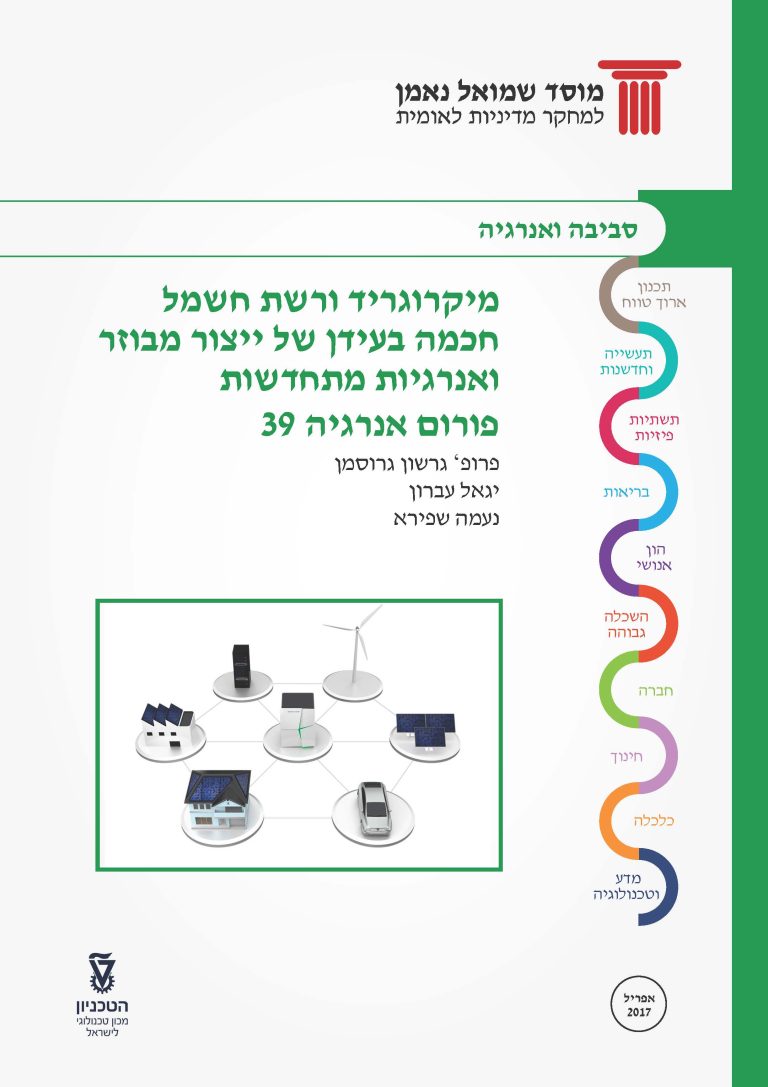Smart Grid is under development in many parts of the world, designed to replace the conventional power supply network. It is one of the leading issues in a modern energy economy and enjoys national priorities and massive investments. In Israel too, the issue is a high priority on the national energy agenda, even though the subject is still in its infancy. A smart grid provides electricity from producers to consumers, combined with fast, bidirectional communication that enables the consumption to be synchronized with the production and operation capacity of Demand Side Management programs. This enables optimization, savings, cost reduction, resilience, collaboration and increased reliability. The smart grid excels in the ability to optimize the power supply to respond to a wide range of situations, to encourage users to change their consumption patterns (such as encouraging use of at low-demand hours) and to charge premiums from consumers using peak energy. When the cost of electricity is low, a smart grid can offer consumers to run energy-intensive household appliances such as washing machines or processes in a factory that can operate at any time. At peak hours, the smart grid can, in coordination with the consumer, turn off selected devices to reduce demand.
One of the goals that a smart grid serves is to introduce renewable energies such as solar and wind into the grid, when available, and use them to replace electricity generation by burning fossil fuels. While there is a clear advantage in the use of these clean energy sources, their introduction into the grid is somewhat problematic, due to their intermittent and sometimes unexpected nature. One of the important challenges in developing the smart grid is finding ways to integrate these resources in the grid, despite these problems.
Another important goal is managing the charging of electric vehicles. Electric vehicles are large consumers of electricity, especially consumers of current when charging. Future electric grid, given the significant penetration of electric vehicles, will need to manage the charging of the electric vehicle intelligently. On the other hand, electric vehicles can also be used as storage stations and provide electricity to the grid when needed. Similarly, it will be possible to manage or receive such services from batteries installed in homes with local electricity generation – for example, solar power.
At the beginning of the development of the Smart Grid, the emphasis was placed on smart metering. Today, there is a great deal of emphasis on decentralized electricity generation – a combination of a network of electricity produced by various manufacturers (beyond the IEC). The proper structure of the grid can be based on microgrids – elements that produce electricity, elements that consume electricity and a part that both produce and consume, interconnected in a management system, usually in a defined geographical area. This is a collection of elements that produce energy (such as a generator, a gas or biogas engine, cogeneration, trigeneration, solar installations, wind turbines, micro turbines), elements that enable energy storage (electrical or thermal) and various elements that are both producers and consumers, managed by smart meters. Each microgrid is largely autonomous and can act as an isolated ‘island’, but is generally linked to external power producers and, if necessary, to other microgrids.
The potential benefits of the microgrid are its ability to increase the reliability of the supply to critical elements, the ability to manage the array, including prioritization during fault times, and cost savings, while integrating and optimizing the entire production system. It enables to manage consumption, while looking at the individual consumer. It can be used in several forms: minimum cost, minimum emissions, maximum availability and load shaving or peak shaving. One can choose the form to work with each day.
Beyond the potential benefits of the power system itself in terms of supply reliability and system survivability, microgrids can significantly contribute to achieving carbon dioxide emission reduction targets as part of addressing climate change. This is because of the possibilities they open for the optimal integration of distributed energy sources (DER) and small and medium-sized production systems that can provide heating/cooling services in addition to electricity, thereby improving the efficiency of energy conversion to desired energy services and reducing demand for electricity.
The benefits of microgrids differ in different cases. The behavior of a kibbutz population is not the same as the behavior of a university campus. An evaluation was presented of five different types of microgrid: a hospital, a kibbutz or a rural collective farm, a large industrial zone, a large residential neighborhood and a university.
Recommendations:
- One of the unknowns to consider is the cost-benefit ratio of microgrid. Pilots should be conducted in real situations and for real consumers, in different types of consumers, in different areas, and to map barriers and benefits according to the different types of microgrids. Methodical measures should be taken to examine all potential benefits and costs and to conduct feasibility surveys, identifying the scale and type of consumers that are economically and strategically optimal (resilience, survivability and economy). At the management level, the price needs not be high, and this will give the regulator the tools to see what the profit will be from releasing money or releasing regulation. The pilots will be established by private companies, at moderate funding, and the information received is expected to benefit greatly.
- It is proposed to carry out feasibility surveys for microgrids by grants and / or tenders funded by the government (the Ministry of Energy), similar to the surveys, which have been established for years, regarding energy efficiency.
- As part of the master plan for the electricity sector, which is under discussion during this period, it is proposed to locate and install regulations and regulatory rules that will enable the construction of a smart electricity grid, with an emphasis on optimal microgrid integration.
- A model is proposed for the ownership and operation of parts of the national grid by private electricity producers, referred to as Independent Grid Operators (IGO). The government will invite such companies to offer a future structure for the smart grid, based on existing technologies or technologies which would exist in the near future, for the construction of microgrids (10-100 MW) throughout the country. The winning bidder will be granted a concession to manage a microgrid / smart grid plan for the government, to examine microgrids. The goal will be to demonstrate significant reduction and price and price stability during the concession period. Based on the recommendations of the aforementioned winning bid, the government will grant licenses for 25 years to own and operate parts of Israel’s electricity grid. The IEC will retain only high-voltage transmission lines and enough production capacity to back up essential services. The license holders will pay the IEC for these services.
This model is not supported by all the Forum participants and it is claimed that other models may be more appropriate.












